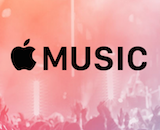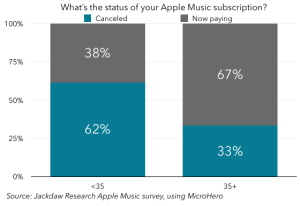 With CEO Tim Cook’s disclosure of Apple Music subscriber numbers (6.5-million paying subscribers; 8.5-million trial subscribers), Apple Music is finally positioned in the music service market. As in physics, where quantum phenomena can be measured either as waves (movement but no location) or particles (location but no movement), we can see Apple Music as holding a particular competitive location.
With CEO Tim Cook’s disclosure of Apple Music subscriber numbers (6.5-million paying subscribers; 8.5-million trial subscribers), Apple Music is finally positioned in the music service market. As in physics, where quantum phenomena can be measured either as waves (movement but no location) or particles (location but no movement), we can see Apple Music as holding a particular competitive location.
Many observers will note that Apple reportedly does not notify trial users when the trial is nearing expiration, so the paying roster probably includes some number of unwilling subscribers. Such is the case with many online subscription plans. Putting that complaint aside, we have to view 6.5-million subscribers as a victorious leap into the music service space, one that verifies the advantage of OS bundling (e.g. making the service a default feature of the world’s second-most popular mobile operating system).
Consider that Rhapsody has about half as many global subscribers, and has been courting them since 2001. Spotify has acquired 20-million monthly subscribers since it launched in 2008.
Detractors will also note that Apple’s 6.5-million credit-card users represent a tiny fraction of hundreds of millions of iPhone and iPad users who were exposed to Apple Music. (Actually, they were exposed only to the iOS upgrade opportunity, without which Apple Music does not exist on their devices. See this critique of how Apple rolled out the service.)
Attempts to invalidate Apple’s progress after its June 30 launch contain truth, but are also beside the point. We put Apple Music next to other music services for apple-to-apple comparisons of consumer willingness to pay for the service. But it’s important to remember that Apple is not in the same business as Rhapsody, Spotify, Deezer, and other music services. Apple is a consumer electronics manufacturer. As such, the acquisition of Beats Music, which resulted in the launch of Apple Music, is more about retaining iPhone and iPad customers than about stealing share from incumbents (or revolutionizing music delivery for a second time).
That’s fortunate, because there is little revolution in Apple Music, and the product is immature compared to its rivals. It is arguably uglier and more difficult to use than its progenitor, Beats Music, and miles away from the deep evolutionary product and usability development that has been layered into Spotify, Rdio, and Rhapsody over many years.
 That might be why Apple Music seems to be retaining older users more than younger users — according to an admittedly small-sample survey from Jackdaw Research released this week. In that study, the older cohort (35+) is pulling out the credit card at twice the rate of under-35 tire-kickers. There is speculation here, that younger users are more familiar with what a highly developed music service looks and feels like, and reject Apple Music on that basis.
That might be why Apple Music seems to be retaining older users more than younger users — according to an admittedly small-sample survey from Jackdaw Research released this week. In that study, the older cohort (35+) is pulling out the credit card at twice the rate of under-35 tire-kickers. There is speculation here, that younger users are more familiar with what a highly developed music service looks and feels like, and reject Apple Music on that basis.
To whatever extent that is true, Apple might not care. The hippest early adopters can immerse themselves in Spotify, Rhapsody, Deezer, and Rdio perfectly well in the Apple device ecosystem. People who are sliding into Apple Music as a first experience with an online jukebox might be well satisfied with the “here it is” convenience of Apple Music appearing on their mobile desktops. The real value of music subscription is the incredible bargain of accessing a giant music library, and Apple delivers that at a standard price point.
The upshot? Apple Music has a tremendous foothold for a three-month-old music service. It has plugged a gaping hole in its ecosystem left over from Steve Jobs’ failure to recognize the future of streaming. And Apple’s immense distribution power will probably keep audience metrics growing much faster than any unaffiliated service could.

